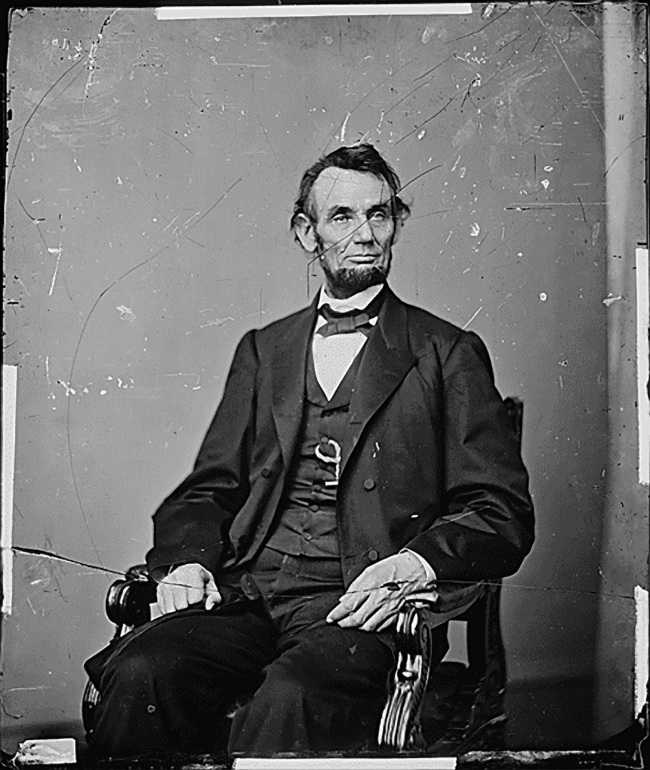 |
Portrait of 16th U.S. President Abraham Lincoln, c. 1861-65. (National Archives/MCT) |
Sometimes political careers are born of chance.
John Nicolay and John Hay were two young men working in Springfield, Ill., when they became involved with the political life of Abraham Lincoln before his 1860 U.S. presidential campaign. Tireless and smart, the friends, still in their 20s, proved themselves indispensable to Lincoln, who brought them along with him to the White House as his personal secretaries ― in effect, the president’s gatekeepers.
In his new book, “Lincoln’s Boys: John Hay, John Nicolay, and the War for Lincoln’s Image,” author Joshua Zeitz skillfully recounts what were heady days for Nicolay and Hay, even as they were tragic days for the nation. The friends lived in the White House and wielded considerable power as advisers and conduits of Lincoln’s orders. Over the four years of the Lincoln presidency, they had as good a view of the unfolding Civil War battles ― both military and political ― as Lincoln himself.
And after the assassination, the friends tasked themselves with chronicling Lincoln’s life, leading to publication of the 10-volume“Lincoln: A History.” The series and the related “Abraham Lincoln: Complete Works” co-edited by the two men remain part of the foundation for how modern Americans view the nation’s 16th president. Or, as Zeitz phrases it, the creation of the “Lincoln Memorial Lincoln.”
Zeitz builds his book on known sources and known histories but turns the glass a bit to give us a different view of an already deeply mined era. So this isn’t a book of revelations but a series of interconnected stories about friendship, political and economic forces that made war over the morality of slavery and about the transformation of personal experience and written records into definitive history.
Those were remarkable days involving remarkable people, and Zeitz does an admirable job bringing them to life, from the boredom Hay felt in returning to Illinois after the excitement of studying at Providence, R.I.’s Brown University to the swirl of activity in the Lincoln White House as the war unfolded to the aftermath of Lincoln’s assassination.
The “boys” were rewarded for their work and loyalty. Each was given a diplomatic post in Lincoln’s second term ― both in Paris ― but Lincoln was killed before they left the U.S.; Hay, in fact, was at Lincoln’s bedside when he died. Andrew Johnson, Lincoln’s successor, honored the appointments and the friends headed for Europe before returning in 1889 to pursue careers beyond Lincoln’s shadow.
The Nicolay-Hay story begins to feel a bit unbalanced after the assassination, but then, that accurately reflects the history. Nicolay was already the powerful editor of an Illinois newspaper when he met Lincoln. Hay at the time was half-heartedly trying to build a legal career in his uncle’s Springfield office, next to the one occupied by Lincoln. After the assassination, Nicolay resumed his newspaper career as editor of the Chicago Republican before returning to Washington as marshal of the U.S. Supreme Court as well as teaming with Hay for the Lincoln biography.
Where Nicolay did well in his post-Lincoln career, Hay soared, in no small part because of his marriage to Clara Stone, daughter of millionaire Cleveland businessman Amasa Stone. Hay’s wealth, and his Lincoln connection, kept him in the top echelon of late 19th century Republican politics.
It also positioned Hay for a unique role in American history. Of the four American presidents assassinated in office, Hay was a close friend and adviser to the first three victims, Lincoln, James Garfield and William McKinley, who first appointed Hay secretary of State.
Hay’s wealth too began to inform his worldview as he turned more conservative and reflective of the upper class. That began to affect the friendship, which is the main narrative string of the book. Late in life Hay and Nicolay continued to vacation together, but as Zeitz writes, “more and more it was history that formed their bond, rather than a commonality of lifestyles or interests.”
Zeitz also offers interesting analyses of the rise of “Lincolnia,” the quest for souvenirs of a man who was not universally admired while he was alive, and of historical revisionism, the pendulum swings of how we perceive the past. He reviews how historians have framed the Civil War and Lincoln as the nation evolved through Reconstruction to the Jim Crow era, then the Great Depression and the Civil Rights era. Along the way the historical prism shifted ― the war was about slavery; no, it was about states’ rights; no, it was about agrarian versus industrial economies, etc.
“From these debates has emerged a nuanced and now predominant historical portrait of a masterful politician who evolved personally over the years in his capacity to envision a biracial democracy,” Zeitz writes, “and who used his mastery of politics to build and then use popular opinion against an institution that he had always despised on a gut level.”
And, Zeitz writes, given Nicolay and Hay’s catbird seat for watching it all unfold, it stands to reason that the history of Lincoln they wrote more than a century ago remains a key source for historians. Now that’s a legacy.
Martelle is the author of “The Admiral and the Ambassador: One Man’s Obsessive Search for the Body of John Paul Jones,” due out in May. ― Ed.
By Scott Martelle
(Los Angeles Times)
(MCT Information Services)





![[Herald Interview] 'Trump will use tariffs as first line of defense for American manufacturing'](http://res.heraldm.com/phpwas/restmb_idxmake.php?idx=644&simg=/content/image/2024/11/26/20241126050017_0.jpg)

![[Herald Review] 'Gangnam B-Side' combines social realism with masterful suspense, performance](http://res.heraldm.com/phpwas/restmb_idxmake.php?idx=644&simg=/content/image/2024/11/25/20241125050072_0.jpg)
![[Health and care] Getting cancer young: Why cancer isn’t just an older person’s battle](http://res.heraldm.com/phpwas/restmb_idxmake.php?idx=644&simg=/content/image/2024/11/26/20241126050043_0.jpg)